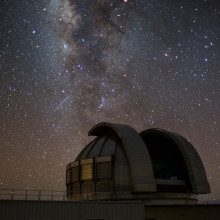Sean asked "Why is it that when you look directly at a small faint star it disappears. But when you look at a point near it, you can see it again?"
Ben McAllister has been searching far and wide for the answer to this cosmological conundrum...
In this episode

00:00 - QotW: How do I see faint stars?
QotW: How do I see faint stars?
This week, Ben McAllister has been looking into this cosmological conundrum from Shawn...
Shawn - Why is it that when you look directly at small faint stars they disappear, but when you look at a point near them you can see them again?
Ben - Mmm, good question Shawn. That one left me feeling a bit dim. It turns out the answer is all to do with a technique known as “averted vision”. And no, we aren’t talking about what you’re supposed to do if the Queen comes in the room. We’re talking about a thing astronomers have been using for centuries to see distant objects.
A few people on the Naked Scientists forum like Colin2B, and Evan AU, and Flummoxed, all phone in with helpful answers which, like a guiding star, pointed me in the right direction. And thanks to Alistair Frith for his very helpful answer by email which shed some light on the subject.
Matt - So this is a really good question.
Ben - I thought so too. Thanks Matt.
Matt - But the answer actually isn't anything to do with astronomy.
Ben - Oh!
Matt - It's all to do with how your eyes work. There are two kinds of cells in your eyes which do the job of detecting light - they're called rods and cones. Cones give us our colour vision but they need very very bright lights to work and they don't do very well at all in dim light or at night. The rods on the other hand are much more sensitive and can see very well in dim light, so it's rods that give us our night vision.
Ben - So it's all about those pesky rods and cones. The fact that cones don't work well in low light is exactly why, if you're looking around in the dark, it's very hard to see colour, and the world appears in greyscale. The colours of light that a given object gives off don't actually change based on the time of day, it's just that the rod cells in your eyes, which worked well in darkness, can't really tell the difference between a red and a green.
Matt - Now the issue that Shawn's noticed comes from the fact that these rods and cones aren't just distributed randomly across your retina. Right in the middle of your retina - the sweet spot of your retina if you like - is a patch called the fovea which contains loads and loads and loads of cones all closely packed together, and this is what gives you your sharp colour vision. When you're looking straight at something in really nice lighting conditions, the reason you can see it so sharply it's all these cones packed together in your fovea.
Ben - So Matt, our astronomer come, I guess, I expert is saying that the middle part of your eye is really good at seeing bright, colourful things and not so great at seeing dim, dark things. You can do a little experiment here to see how this works for yourself. If you aren't actually colourblind you can go ahead and google 'colourblindness test' and pull up one that looks appealing.
If you look at it dead on, you should be able to see the different colours pretty clearly because of all those wonderful cones in the middle part of your eye. But, if you look at point on your screen off to the side so that use see the test with your peripheral vision, even in good light you'll probably find it much harder. If you are colourblind well I'm sorry, you're just going to have to take my word for it.
Anyway, back to Shawn's question; how does this relate to our ability to see dim objects like stars?
Matt - The problem is that all these densely packed cones right in the middle of your retina are the ones that really struggle to see things in dim light. So when you look at something very small and very dim, like a star, all the light's going to be falling straight on the part of your eye that really struggles to see faint things. So what you have to do, you have to move your eyes a bit to the sides and then the light will be falling onto a region with more rods which do a much better job of seeing in the dark, and so you can see the star better.
Ben - So it's the exact opposite of our color blindness test. The side parts of your eyes might be much worse at seeing colours, but they're much better at seeing faint things. So there you have it Shawn, is all about understanding the human body's odd little quirks and using them to our advantage.
Thanks to Dr Matt Bothwell for illuminating the question for us as we were a little bit in the dark. Okay... I'll stop now.
Join us next week when we tackle this breathtaking question from Greg in Canberra, Australia:
Greg - When I exhale my breath contains carbon atoms, how long ago were they in my food or drink?
Related Content
- Previous Vets Beyond Pets
- Next eLife Episode 56: Vaccines and viral swarms










Comments
Add a comment